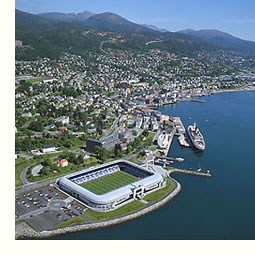
The Aker Stadion is an all-seater football stadium located at Reknes in Molde, Norway, and is the home of Eliteserien club Molde. The stadium has a current capacity of 11,249 spectators.

Ullevaal Stadion is an all-seater football stadium located in Oslo, Norway. It is the home ground of the Norway national football team, and the site of the Norwegian Cup Final. From its opening in 1926 to 2009 it was the home ground of FK Lyn and from 1999 to 2017 was a home ground of Vålerenga IF. With a capacity of approximately 28,000, it is the largest football stadium in Norway. The national stadium is fully owned by the Football Association of Norway (NFF).

Aspmyra Stadion is a football stadium in Bodø, Norway. Home of Bodø/Glimt and Grand Bodø, it holds a seated capacity for 8,270 spectators. The venue has four stands: a modern all-seater with roof, 100 club seats and 15 luxury boxes to the south, unroofed all-seater stands to the east and west and two stands to the north. An older raised grandstand with roofing at the back and a new all-seater unroofed stand in front. Before this new stand was built the area in front of the old stand was a standing area that could hold approximately 2000 people, but did not fulfill UEFA safety regulations for international matches. The venue has floodlights and artificial turf with under-soil heating. Immediately south of the venue lies Aspmyra kunstgressbane, a training pitch with artificial turf. Aspmyra Stadion has hosted one Norway national football team match, against Iceland in 2002.
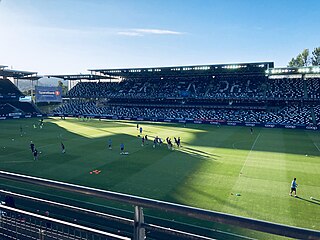
The Lerkendal Stadion is an all-seater association football stadium located at Lerkendal in Trondheim, Norway. The home ground of the Eliteserien (2017) side Rosenborg BK, it has a capacity for 21,405 spectators, making it the second-largest football stadium in the country.

Lillestrøm idrettspark, colloquially known as Lillestrøm stadion, is a sports facility located at Lillestrøm in Skedsmo, Norway. The main venue is Romerike friidrettsstadion, an athletics stadium with eight all-weather running tracks. It has multiple football pitches, including one with artificial turf and one with gravel. The park features of two arenas, LSK-Hallen with a full-size artificial football pitch and Skedsmohallen for indoor sports. The venue is located adjacent to Åråsen Stadion, the home ground of Lillestrøm SK. The main tenants for Lillestrøm idrettspark are Flisbyen BK and Focus FK in football, and Strømmen IF, Lørenskog FIL and Minerva IS in athletics. The stadium opened on 6 June 1920 and was the main venue for Lillestrøm SK until 1951. The athletics stadium opened two years later. In 2004, the artificial turf pitch was laid and in 2007 a new athletics venue and LSK-Hallen opened.

Voldsløkka Stadion is a sports stadium in Oslo, Norway.
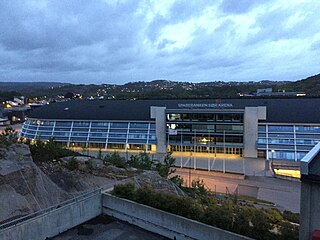
Sparebanken Sør Arena is a football stadium located at Torsvika in Kristiansand, Norway. The all-seater has a capacity of 14,563 people, and serves as the home ground of Tippeligaen side IK Start. It was designed by Kjell Kosberg, and is architecturally similar to Aker Stadion. The venue has seen concerts by Elton John, Dolly Parton and A-ha, among others.. UEFA refers to the stadium as Kristiansand Arena.
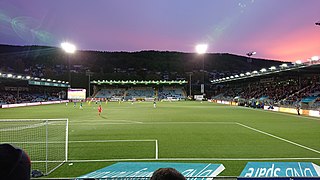
The Marienlyst Stadion has been the home ground of Strømsgodset Toppfotball since 1967. It's located on Marienlyst in Drammen, Norway.

Sparta Amfi is an indoor ice hockey rink located in Sarpsborg, Norway. The 3,900-spectator venue is the home of Sparta Sarpsborg and Sarpsborg Skøyteklubb. The arena opened in 1963 as the first indoor ice rink in Norway. Major upgrades were carried out in 2006 and 2012, and a second rink opened in 2007.
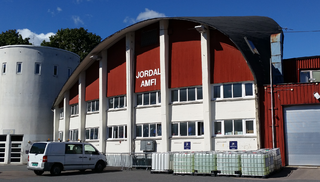
Jordal Amfi was an indoor ice hockey rink in Oslo, Norway, the first bearing that name. The venue opened in 1951 to host the 1952 Winter Olympics. Jordal was also the site of the 1958 and the 1999 IIHF World Championship. It would in the following decades also serve several boxing matches and concerts.

Haugesund Stadion, currently named Haugesund Sparebank Arena for sponsorship purposes, is a soccer-specific stadium in Haugesund, Norway. Haugesund Stadion is the home ground of Eliteserien team FK Haugesund and 2. divisjon team SK Vard Haugesund.
The Sarpsborg Stadion is a football stadium in Sarpsborg, Norway. It is the home ground of Eliteserien club Sarpsborg 08.

Frogner stadion is a sports stadium in Oslo, Norway, which has artificial ice in the winter for speed skating and bandy. The artificial grass is used in the summer for soccer and American football. It is located close to the Frogner Park, between the park and Majorstuen. One match, Norway-Belarus, was played here at the 2013 Bandy World Championship.

Kadettangen is a small peninsula outside of Sandvika in Bærum, Norway. Originally named Sandvikstangen, it got its current name from the cadet training conducted by the Norwegian Military Academy for the better part of the nineteenth century. The peninsula is now used mainly for boating, beach life and sports, being the home ground of association football club Bærum SK.
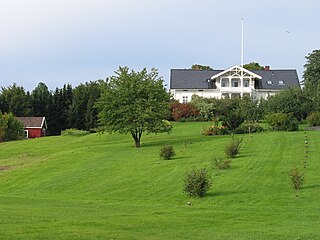
Nadderud is a district in eastern Bærum, Norway. It was formerly farmland under one of Bærum's larger farms, named Nadderud, but since the 1950s it has been built up with housing, several schools and sporting facilities. The best known facility, which has made the name Nadderud nationally known, is the stadium Nadderud stadion. Parts of the district Nadderud have been absorbed by the growing suburban centre Bekkestua.

Dælenenga idrettspark is a sports facility located at Grünerløkka in Oslo, Norway. It consists of an artificial turf football pitch, a club house and an indoor ice rink—Grünerhallen. The facilities are owned by the Municipality of Oslo and used and operated by Grüner IL, the local sports club.

Hamar stadion is a former athletics, speed skating and bandy stadium in Hamar, Norway. The home ground of Hamar IL, it was owned by Hamar Municipality. It has held seven international speed skating events: the European Speed Skating Championships in 1934, 1948 and 1953, the World Allround Speed Skating Championships for Men in 1952 and 1985, and the World Allround Speed Skating Championships for Women in 1980 and 1991. The stadium has held 13 Norwegian Championships and 11 world records have been set at the venue.

Jordal Idrettspark is a multi-sports complex located at Jordal in Oslo, Norway. Owned by Oslo Municipality, its main tenant is Vålerengens IF. The main components are two ice hockey rinks, Jordal Amfi and Ungdomshallen, and a football stadium, Jordal Stadion.

Norway's Bandy Association is the governing body for the sports of bandy, floorball and field hockey in Norway.






















